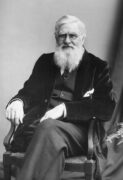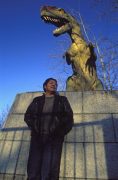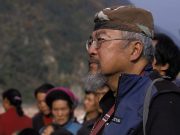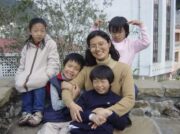本月 [2013 年 4 月],氣候科學家 Dr。詹姆斯漢森退役 擔任美國太空總署戈達德太空研究所所長。然而,72 歲的漢森並沒有追求工作後的悠閒生活,而是計劃將自己的時間更好地集中在氣候科學上,同時傳播科學及其政策影響。
對政府科學家來說,這是一個奇怪的選擇。但漢森長期以來一直是個特立獨行的人,他的職業生涯使他從調查金星大氣層,透過研究和表達對氣候變遷的擔憂,到因反對化石燃料開採和使用而被捕。
20 世紀 60 年代末,漢森獲得了美國宇航局的研究生實習機會,這使他花了十多年的時間研究金星,他認為金星的表面非常熱,因為金星的大氣層捕獲了太陽的熱量。他參與了先驅者號任務,但辭職去研究地球,因為正如他後來所寫的那樣:“我們家鄉星球的大氣成分正在我們眼前發生變化……這肯定會影響地球的氣候。”
那時,漢森知道二氧化碳決定了火星和金星的氣候。在接下來的十年裡,他和一小群氣候科學家表明,這對地球也很重要,排放量的增加可能導致全球氣溫上升。 1988年,漢森在美國參議院委員會作證時宣稱,“是時候停止胡言亂語了,說有相當有力的證據表明溫室效應已經存在。”
這標誌著科學家們對這個問題的嘗試性轉變。第二天,一個 紐約時報 標題宣布:“全球暖化已經開始。”
漢森的信心是基於對地球能量平衡以及擾亂平衡的「強迫」的研究。近年來有九個主要強迫因素。其中兩個是完全自然的:太陽亮度的波動和火山活動。其餘的則是人類造成的,包括土地覆蓋變化、散射和吸收陽光的氣溶膠、二氧化碳和其他溫室氣體。
地球過去已有的證據表明,隨著時間的推移,即使是很小的強迫變化也會導致非常大的影響。地軸的微小傾斜和軌道的變化可能決定冰河時期的開始還是結束,陽光的持續變化會導致反饋機制,例如二氧化碳水平上升並導致更嚴重的變暖,進而導致更多的二氧化碳被釋放。
2001 年,當漢森前往參加內閣級氣候工作小組會議時,他很清楚,過去幾十年中增加的人為強迫已經使 1750 年以來的自然強迫相形見絀——這一時期包括 2001 年後期。時代。他在演講中展示了一個聖誕樹燈泡,並解釋說,其淨效應相當於在地球表面的每平方公尺上日夜燃燒兩個聖誕樹燈泡。雖然這種影響在日常基礎上很小,但在數十年和數百年中,其作用力卻是巨大的。
即使有了聖誕樹燈泡,工作小組成員也發現氣候變遷科學很難遵循。對於漢森及其同事提出的替代方案(重點是減少污染)並沒有達成一致。第二次會議舉行了,這次由麻省理工學院教授理查德·林森(Richard Lindzen)發表演講,漢森稱之為「全球暖化逆向論者的院長」。林岑表示,全球暖化存在不確定性,並表示一些科學家發表了「危言聳聽」的言論。專案組成員感到困惑。
特殊利益和政府綠色清洗
但對氣候變遷的困惑並不僅限於少數工作小組成員。在他的書中 我孫輩的風暴漢森寫道,“特殊利益集團的不當影響和政府的‘綠色清洗’對消息靈通的公眾構成了巨大的障礙。” 2004年和2005年,漢森甚至面臨氣候變遷的高層審查。隨後的一份報告發現,美國太空總署公共事務辦公室減少、邊緣化或錯誤地向公眾提供氣候變遷科學知識。
漢森拒絕被封口。部分是出於對孫輩的思念和人為氣候變遷的代際不平等,他越來越努力地向公眾,特別是年輕人闡明其影響。
漢森認為,人類正處於一個岔路口。未來的一條潛在途徑是迅速減少化石燃料排放。另一個是或多或少一切如常,預計這將導致反饋放大,氣候變遷失控。
地球的歷史表明,一切照舊的做法可能會產生一些潛在後果。過去7000年來,海平面異常穩定,這可能促進了文明的發展。然而,隨著冰蓋融化和崩塌,海平面每世紀可能會上升幾公尺。放大反饋可以包括釋放凍結在海底的甲基水合物,並可能排放甲烷(一種強效溫室氣體)。
漢森認為,這種變化最終將使地球的某些地區不再適合人類居住。但即使是短期影響也會產生重大影響,例如他認為將成為本世紀氣候特徵的風暴。漢森寫道,「氣候骰子」現在越來越傾向於更嚴重的風暴和更極端的熱浪。
儘管漢森有時被稱為“全球暖化教父”,但有些人認為氣候變遷是一種威脅,但對他的倡導和直言不諱持謹慎態度。有些人反對他的觀點,即我們需要提高化石燃料的費用,將紅利返還給人們,而不是增加政府的金庫。
即便如此,對許多人來說他仍然是英雄。 「詹姆斯漢森是良心的有力代言人,」塞拉俱樂部執行董事邁克爾布魯恩在給協會的一封信中寫道。 紐約時報 上個月。 “他值得我們尊重,因為他是最早在氣候破壞意識早期站出來並要求我們的領導人採取行動的人之一。”
頂尖人物
南海颱風襲來,直升機乘務員冒著大風大浪救援海員
2022年7月2日上午,大風暴雨襲擊香港……
詹姆斯·雷諾茲 (James Reynolds) 颱風獵人和火山攝影師
超強颱風杜娟28日晚襲擊台灣東北部,密切關注風暴……
馬賽野生動物探險導遊 Jackson Looseyia
壞味道的血液 我的家鄉大約有 15 個人。我們認為...
適合所有序列的人 Frederick Sanger
2013 年 11 月,克雷格·文特爾(Craig Venter)描述了一名男子的死亡,他是……的先驅之一。
藍光最終為 LED 巨頭贏得諾貝爾獎
雖然 2013 年諾貝爾物理學獎是為了獎勵深奧的知識進步——理論工作……
叢林天才:阿爾弗雷德·拉塞爾·華萊士
最近有消息稱,一項研究發現加拉帕戈斯野生動物的分佈和進化......
蝴蝶和傑出的霍夫施塔特教授
今年春天,物理學界興奮不已,因為長期預測的蝴蝶被證明了……
潘文石:為熊貓而戰的科學家
在酉水河支流附近的一個山洞裡,潘發現了八歲的嬌嬌……
吉爾羅賓遜幫助熊
吉爾·羅賓遜先是感到震驚,然後她出發去阻止受苦的大熊……
Jessie Yu – 香港單親協會創始人
這位不知疲倦的香港慈善家表示,取得成功的最好方法就是幫助自己……
國王的守護者:圈養繁殖菲律賓鷹
在溫暖、陽光明媚的天氣裡,一個人的毅力為極度瀕危的猛禽帶來了希望……
楊立和醫生幫助麻風病患者
楊立和醫生一生致力於治愈麻風病。現在他正在幫助以前的病人……
恐龍獵人董志明
挖掘中國真龍 26歲的董志明走在紅黃相間的低矮懸崖上……
勇敢的直升機機組人員從九龍嘉利大廈著火的屋頂進行了戲劇性救援
邁克·埃利斯機長駕駛西科斯基黑鷹飛機駛向陷入困境的 16 層加利大廈,位於……
Mountain Dog 與中國重建學校
我在香港的一個慈善舞會上,坐在明亮的......
柯媽媽為正義而戰
立法者越忽視她,她就越堅定地在灰色地帶尋求正義……
非典醫生、女主角蘇燕妮
一種神秘的疾病正在將醫護人員一一擊倒。他們怎麼可能打架……
艾倫·連恩
2002 年 10 月,一箱箱衣服開始運抵西非國家布基納法索……
林老師幫助台灣的孩子
林老師有一個夢想,讓越來越多的貧困孩子找到溫馨的家……












